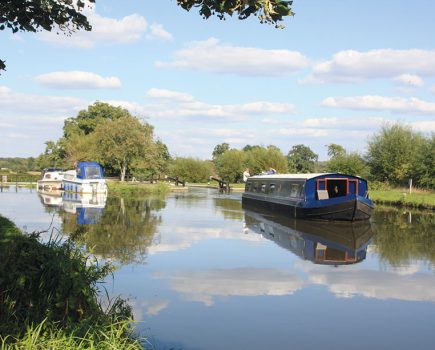Your lines can do a lot more for you than just help you hug the bank securely, especially when it’s windy

Words: Steve Vaughan; Pictures: Nick Wall
Mooring lines – the clue’s in the name – are used primarily for mooring your boat. But in the right hands, they can be used for much more, making some boating tasks easier and, in some cases, make the impossible possible.
If you have been around seagoing yachts then terms like ‘springing’ would be second nature. Their high sided, light hulls and proximity to coastal winds make yachts susceptible to being blown around. At sea, this isn’t usually a problem but it can be when manoeuvring in tight harbours.
Their method of choice for dealing with this is the use of ‘springs’, lines tied between the boat and the dock. There will be other names but, generally, the one at the front of the boat is the ‘bow spring’ and the one at the back is the ‘stern spring’.

1) Springing on
Picture the scene: You selected an idyllic mooring complete with rings and a low hedge on the towpath side so you have a nice view across the open fields. The problem is that a strong wind is blowing off the towpath. You manage to put a crew member off with the bow line but now the crew is hanging on for grim death and the stern is being blown across the canal with no way of being pulled back in.
The first answer is to find somewhere else for the night. The second is to spring your boat on to the mooring using the following method.
The crew need to step off at the bow and work fairly quickly to take the bow line to a mooring ring or bollard aft of the bow and up to halfway along the length of the boat.

Two or three turns through the ring, (use a loop rather than feed the whole line through) or round the bollard will be enough for the crew to hold the boat by hand while you engage forward gear on tickover and watch a miracle.
No matter how strong the wind, the boat, with you adjusting the rudder to suit, will gradually arc its way to come parallel alongside the mooring.
The crew can tie off the bow line with a couple of half hitches while you stay at the helm keeping the boat in gear. This is called ‘steaming on a spring’ and it will hold the boat alongside while the crew tie off the stern line. If you have a second bow line, as many of us do, then the crew can now tie off the bow.
If you don’t have a second bow line, the crew can take hold of the centre line and temporarily secure it through another ring. You can then take the boat out of gear, get off the boat, walk forward and untie the bow line from its springing position and take it forward to tie off the bow as usual.

Job done!
The same method can be used to spring on to a lock landing but the boat can remain steaming on a spring until the lock is ready. For safety reasons, the helmsman should always stay at the engine controls whenever the boat is in gear.
2) Springing off
This can be used to get the boat off a mooring when the wind or water flow is holding you into the side.

Although the wind will be keeping you held in to the bank, it is a good idea to use the centre line to tie off the boat temporarily. Untie the bow line and stow it on the boat before untying the stern line, but don’t remove it from the stern dolly. Instead, set it up so the line runs from the dolly to the ring or bollard on the towpath and back to the boat where it should be connected to the dolly using three or four turns.
There should be about 2m of line between the dolly and the ring or bollard. Don’t tie off the line but you need to be able to hold the line tight or the turns will come undone.
After removing the safety centre line, stow it on the roof near the helm as usual and take a good hold of the stern line. Now select reverse gear so the boat moves astern but do it slowly until the slack in the stern line is taken up. You might find tickover is too fast so slip it in and out of gear if necessary.
The stern line should now be tight and at an angle running forward of the stern. Keep the boat in gear on tickover and, gradually, you will see the bow spring away from the bank.

Depending on a number of factors, including the shape of your stern, you may need to increase the speed of the engine and/or length of the spring line to get the desired effect but it works on most hulls.
Maintain the springing until the bow is well past where you need it to be pointing. This will give you time to slip the line, (pull it back on board), from the ring or bollard, engage forward gear and move off before the wind pushes you back in.
3) Springing off the stern
Occasionally, it may be more convenient to spring the stern out first but you will need a crew member to help you.

Untie the boat as before but this time, have the crew take the bow line from the boat, through a ring or round the bollard toward the stern and back to the tee stud (or whatever you have at the bow), leaving as much line out as possible but enough to wrap the line round the tee stud and hold it tight.
Put the boat into forward gear and slowly take up the slack. Now steer the boat into the bank and the stern will spring out into the waterway. Keep going until it is further out than you need before selecting neutral. The crew can now slip the bow line and you reverse way from the bank. Once far enough out and with your propeller in deep water, engage forward gear and move off as normal.
Throughout any springing manoeuvre, but particularly springing on and off, it is good advice to use fenders to protect the bank and your boat, especially if you have a fibreglass cruiser.
4) Mooring on spring lines

Most boaters use just two mooring lines, at the bow and stern, which is the reason moored boats are sensitive to passing boats on narrow and shallow canals. The passing boat displaces water, which drags the moored boat forward or back and slackens the lines. Using spring lines will greatly lessen this effect.
Ideally, use two lines at the bow and two at the stern. Tie up as usual with the lines running fore and aft at around 45 degrees to the boat. Then tie two more lines, one running forward from the stern dolly and one running back from the tee stud. These two lines can be fairly long but consider the possible trip hazards.
If you don’t have enough mooring lines, you can use one line at each end and run it in a triangle from the boat to the mooring pin, ring or bollard, along to the other pin, ring or bollard and then back to the boat. Make sure the line is properly tied off at each or it will just run through.
Using spring lines is effective for mooring up on pins in soft ground and on rivers where the level may rise and fall overnight. In the latter case, keep the lines as long as possible.

5) Other uses for springs
Spring lines can be used for turning corners into the wind or to prevent the wind taking you where you don’t want to go.
A centre line is usually the best for this but great care needs to be taken if it is connected to the roof, as it is on most narrowboats, when it might make the boat list over. Most cruisers have centre cleats at deck level, which are ideal.
Providing the boat is moving slowly, the centre line can be used to spring by hand into a lock landing. As you are coming alongside, use the engine to slow the boat right down to a slow crawl, step off with the centre line, take the line through a ring or round the bollard but only use one turn so it can be paid out as it comes under tension and gently spring the boat in. Don’t try to stop the boat too quickly if the line is connected to the roof as it will try to tip the boat.
Springs can come in handy in locks to keep the boat tight into the side on broad locks and when operating the locks single-handed. Care has to be taken with the latter to ensure the boat isn’t hung up on the lines.
Finally
Hopefully, by now you will appreciate using spring lines can be very useful. Remember many of the exercises put the line under more tension than just mooring so you must ensure your lines are suitable for the load, are in good condition and free of cuts and knots that might reduce the strength.
Listen to your line, too. If it is starting to make noises, then perhaps you are straining it too much and need to find another way. When it is under tension, you might want to keep people out of the area just in case the line snaps.
Used properly, however, springs can be a great asset to boating. Try it out next time you are cruising. It’s cheaper than a bow thruster.
____________________
You may also like:
Image(s) provided by:
Archant







